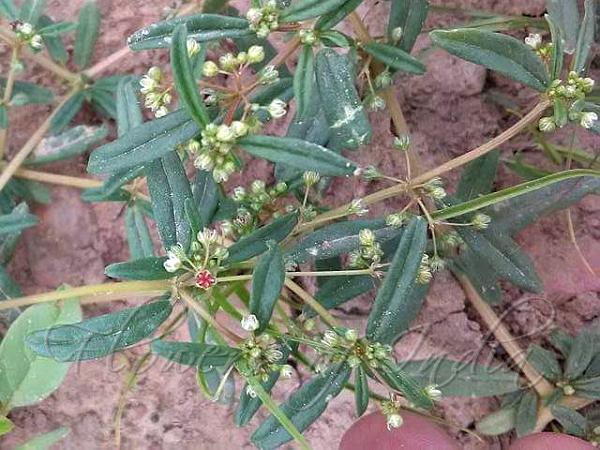|
| Gisekia |
|

|

|
|
|
|
Photo: |
Botanical name: Gisekia pharnaceoides Family: Molluginaceae (Carpetweed family)
Synonyms: Gisekia linearifolia, Gisekia molluginoides, Gisekia rubella
Synonyms: Gisekia linearifolia, Gisekia molluginoides, Gisekia rubella
Gisekia is an annual herb, 20-50 cm, prostrate. All
parts are streaked with linear white raphides. Leaf-stalks are poorly
defined, 2-10 mm; leaf blade elliptic, lanceshaped, or spoon-shaped,
1-2.5 cm x 4-10 mm, both surfaces with many white raphides, base
narrowed, tip blunt or somewhat pointed. Flower clusters are mostly
stalkless, apparently in leaf-axils, densely umbel-like. Flowers are
5-20. Flower-stalks are 3-5 mm long, tepals 5, green (to red), ovate,
1.5-2 mm, tip pointed. Stamens are 5, about 1 mm; filaments flattened
and dilated at base. Carpels are 5; styles short. Mericarp
kidney-shaped, mostly spiny tuberculate, sometimes also some smooth,
surrounded by persistent tepals. Gisekia is found in open, sandy
habitats, often near the sea, or in deserts, at low elevations. It is
found in Afghanistan, India, Pakistan, Thailand, Vietnam; tropical and
subtropical Africa.
Medicinal uses: In East Africa the whole plant
is eaten as a general strength restorative, typically after
miscarriage. In northern Africa Gisekia is considered a purgative, in
Kenya, Tanzania, southern Africa and Madagascar it is taken to cure
diarrhoea. In India, Indonesia, South Africa and Madagascar it is used
as a taenicide, but the plant should be consumed with great caution. In
West Africa leaves are rubbed on swellings and in Tanzania the stem,
pounded in butter, is placed on aching muscles. In India plant sap is
used against warts. In Tanzania cooked green leaves are eaten to treat
asthma, in Kenya the roots are made into a chest medicine. The seeds
probably possess anthelmintic properties.
In East Africa the whole plant
is eaten as a general strength restorative, typically after
miscarriage. In northern Africa Gisekia is considered a purgative, in
Kenya, Tanzania, southern Africa and Madagascar it is taken to cure
diarrhoea. In India, Indonesia, South Africa and Madagascar it is used
as a taenicide, but the plant should be consumed with great caution. In
West Africa leaves are rubbed on swellings and in Tanzania the stem,
pounded in butter, is placed on aching muscles. In India plant sap is
used against warts. In Tanzania cooked green leaves are eaten to treat
asthma, in Kenya the roots are made into a chest medicine. The seeds
probably possess anthelmintic properties.
Medicinal uses:
 In East Africa the whole plant
is eaten as a general strength restorative, typically after
miscarriage. In northern Africa Gisekia is considered a purgative, in
Kenya, Tanzania, southern Africa and Madagascar it is taken to cure
diarrhoea. In India, Indonesia, South Africa and Madagascar it is used
as a taenicide, but the plant should be consumed with great caution. In
West Africa leaves are rubbed on swellings and in Tanzania the stem,
pounded in butter, is placed on aching muscles. In India plant sap is
used against warts. In Tanzania cooked green leaves are eaten to treat
asthma, in Kenya the roots are made into a chest medicine. The seeds
probably possess anthelmintic properties.
In East Africa the whole plant
is eaten as a general strength restorative, typically after
miscarriage. In northern Africa Gisekia is considered a purgative, in
Kenya, Tanzania, southern Africa and Madagascar it is taken to cure
diarrhoea. In India, Indonesia, South Africa and Madagascar it is used
as a taenicide, but the plant should be consumed with great caution. In
West Africa leaves are rubbed on swellings and in Tanzania the stem,
pounded in butter, is placed on aching muscles. In India plant sap is
used against warts. In Tanzania cooked green leaves are eaten to treat
asthma, in Kenya the roots are made into a chest medicine. The seeds
probably possess anthelmintic properties. | Identification credit: Ankush Dave | Photographed in Agra, Uttar Pradesh. |
• Is this flower misidentified? If yes,